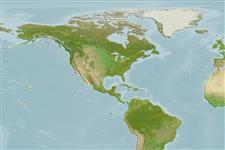>
Perciformes/Zoarcoidei (Eelpouts and pricklebacks) >
Zoarcidae (Eelpouts) > Lycodinae
Etymology: Lycenchelys: Greek, lykos = wolf + Greek, enchelys, -yos = eel (Ref. 45335); folletti: Named in honor of Mr. Wilbur Irving ("Bill") Follett, late curator in the Department of Ichthyology, California Academy of Sciences..
Environment: milieu / climate zone / depth range / distribution range
Ecología
marino batidemersal; rango de profundidad 660 - 953 m (Ref. 35910). Deep-water
Eastern Central Pacific: Gulf of California to central Mexico.
Tamaño / Peso / Age
Maturity: Lm ? range ? - ? cm
Max length : 15.8 cm TL macho / no sexado; (Ref. 35910)
Maximum length based on a juvenile specimen. Feeds on gastropods.
Life cycle and mating behavior
Madurez | Reproducción | Puesta | Huevos | Fecundidad | Larva
Anderson, M.E., 1995. The eelpout genera Lycenchelys Gill and Taranetzella Andriashev (Teleostei: Zoarcidae) in the eastern Pacific, with descriptions of nine new species. Proc. Calif. Acad. Sci. 49(2):55-113. (Ref. 35910)
IUCN Red List Status (Ref. 130435)
Threat to humans
Harmless
Human uses
Más información
Nombres comunesSinónimosMetabolismoDespredadoresEcotoxicologíaReproducciónMadurezPuestaAgregación para la puestaFecundidadHuevosEgg development
Age/Size
Crecimiento
Length-weight
Length-length
Length-frequencies
Morfometría
Morfología
Larva
Dinámica larvaria
Reclutamiento
Abundancia
BRUVS
ReferenciasAcuiculturaPerfil de acuiculturaRazasGenéticaElectrophoresesheritabilidadEnfermedadesProcesamientoNutrientsMass conversion
ColaboradoresImágenesStamps, Coins Misc.SonidosCiguateraVelocidadTipo de nataciónSuperficie branquialOtolitosCerebrosVisión
Herramientas
Special reports
Download XML
Fuentes de Internet
Estimates based on models
Preferred temperature (Ref.
123201): 4.3 - 4.9, mean 4.5 °C (based on 5 cells).
Phylogenetic diversity index (Ref.
82804): PD
50 = 0.5000 [Uniqueness, from 0.5 = low to 2.0 = high].
Bayesian length-weight: a=0.00120 (0.00057 - 0.00252), b=3.10 (2.91 - 3.29), in cm total length, based on LWR estimates for this (Sub)family-body shape (Ref.
93245).
Nivel trófico (Ref.
69278): 3.4 ±0.58 se; based on food items.
Resiliencia (Ref.
120179): Medio, población duplicada en un tiempo mínimo de 1.4-4.4 años (Assuming tmax>3).
Fishing Vulnerability (Ref.
59153): Low vulnerability (10 of 100).
